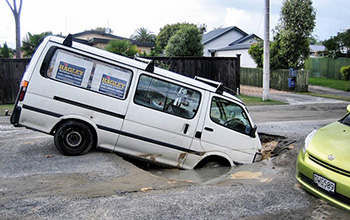Homes and offices are only as solid as the ground beneath them. When that solid ground turns to liquid — as sometimes happens during earthquakes — it can topple buildings and bridges. The phenomenon is known as liquefaction, and it was a major feature of the 2011 earthquake in Christchurch, New Zealand, a magnitude 6.3 quake that killed 185 people and destroyed thousands of homes.
An upside of the Christchurch quake was that it was one of the most well-documented in history. Because New Zealand is seismically active, the city was instrumented with numerous sensors for monitoring earthquakes. Post-event reconnaissance provided a wealth of additional data on how the soil responded across the city.
“It’s an enormous amount of data for our field,” said researcher Maria Giovanna Durante. “We said, ‘If we have thousands of data points, maybe we can find a trend.'”
Durante works with Ellen Rathje, an engineer at The University of Texas at Austin and principal investigator of the U.S. National Science Foundation-funded DesignSafe effort, which supports research across the natural hazards community.
Rathje’s research on liquefaction led her to study the Christchurch event. She had been thinking about ways to incorporate machine learning into her research and this case seemed like a great place to start.
The researchers developed a machine learning model that predicted the amount of lateral movement that occurred when the Christchurch earthquake caused soil to lose its strength and shift relative to its surroundings. The results were published in Earthquake Spectra.
“It’s one of the first machine learning studies in our area of geotechnical engineering,” Durante said.
This new paradigm of data-sharing and collaboration is central to DesignSafe and helps the field progress more quickly, according to Joy Pauschke, a program director in NSF’s Directorate for Engineering.
“Researchers are beginning to use AI methods with natural hazards research data, with exciting results,” Pauschke said. “Adding machine learning tools to DesignSafe’s data and other resources will lead to new insights and help speed advances that can improve disaster resilience.”
The researchers used the Frontera supercomputer at the Texas Advanced Computing Center, one of the world’s fastest, to train and test the model. TACC is a key partner in the DesignSafe project, providing computing resources, software and storage to the natural hazards engineering community.
Source: nsf.gov









